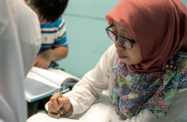International support and competitive regulatory policies in key growth areas, such as stem cell research, are helping drive development in Indonesia’s nascent research and development (R&D) industry.

In April the UK’s Newton Fund Indonesia announced plans to increase its annual allocation of matching funds for research projects in the country from $2.6m to $3.9m, adding to the $10.3m worth of support the fund has provided to some 21 projects over the last few years.
As part of the conditions of the funding, Indonesian researchers must partner with UK institutions to carry out the research jointly, which could help foster closer cooperation and knowledge transfer in the areas of study targeted – ranging from food and energy security, to health and life sciences.
New budget underscores importance of private funding
The announcement followed the release of the draft 2017 budget, which cut R&D funding at state universities from Rp250bn ($18.7m) to Rp150bn ($11.2m).
While the government had previously pledged to double the country’s research fund, fiscal constraints, large-scale infrastructure projects and preparations for the 2018 Asian Games, which Indonesia will host, have limited the availability of public resources.
As such, the government is increasingly advocating for a higher degree of cooperation between the public and private sectors, and a greater emphasis on applied research, to help generate the necessary investment.
One key player in this respect is the Indonesian Science Fund (DIPI). Established in 2016, the DIPI is the first publicly supported research organisation in Indonesia, and is responsible for identifying and funding projects that help develop the local scientific community.
While the DIPI receives some funding from the Indonesian government – specifically, from investment income generated by the Indonesian Endowment Fund for Education – it is also supported by contributions from international agencies, such as the US Agency for International Development and the Newton Fund.
Making greater use of these sources could help reduce the DIPI’s dependence on public spending, and move the fund closer to its long-term goal of self-reliance.
Spending level increasing from a low base
While R&D spending as a share of GDP is still relatively low in Indonesia – at less than 0.1%, compared to 2.19% in Singapore and 1.26% in Malaysia, according to World Bank figures – other indicators suggest activity in this area is accelerating.
In a 2016 report, the World Intellectual Property Organisation (WIPO) ranked Indonesia among the top-20 countries in the world in terms of growth in the number of patent applications filed. The number of filings increased by some 14.1% in 2015, up from average annual growth of 7.8% in 2005-15 – though it is worth noting that non-resident applications accounted for the bulk of this increase.
Rankings on the 2017 Global Innovation Index also demonstrated progress. Although Indonesia ranked relatively low in terms of total spending on R&D, at 105th out of 127 countries, it scored significantly higher on university/industry research collaboration (27th), cluster development (28th), and graduates in science and technology (47th).
Stem cell research opportunities
One of the areas where Indonesia may be best placed to compete on a global scale is stem cell research and applied therapy.
Though local research is still in its early stages, the country offers some marked advantages over other countries in the region and farther afield. Singapore, for example, has banned the use of stem cell therapy, and the US has only recently eased strict controls. Indonesia, meanwhile, has been moving to grow this field through a combination of research and regulation.
Solidifying its position as a major player in stem cell research, in 2014 Indonesia became the first country in South-east Asia to approve an allogeneic stem cell trial.
In contrast to autologous transplantations, which come from an individual’s own cells, allogeneic stem cell therapy opens the possibility for stem cell donation, which could significantly expand the application and penetration of stem cell therapy.
There are currently 11 Indonesian university hospitals authorised to perform stem cell research and provide patients with stem cell treatments. This number is expected to increase as the government eases regulations and researchers find further applications for stem cell therapies.
Expanding this research in Indonesia could also offer more extensive benefits, including raising its R&D profile and attracting international experts to its labs, according to Endang Hoyaranda, president director of Prodia.
“The development of stem cell research in Indonesia may provide opportunities for doctors and scientists from countries where such undertakings are prohibited,” she told OBG.


